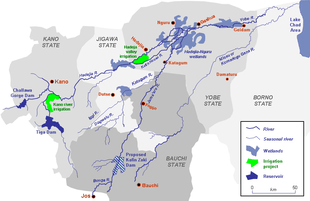Tiga Dam
The Tiga Dam is in Kano State in the Northwest of Nigeria, constructed in 1971–1974. It is a major reservoir on the Kano River, the main tributary of the Hadejia River.

Description
The dam was built during the administration of Governor Audu Bako in an attempt to improve food security through irrigation projects.[1] The dam covers an area of 178 square kilometres (69 sq mi) with maximum capacity of nearly 2,000,000 cubic metres (71,000,000 cu ft).[2] Water from the dam supplies the Kano River Irrigation Project as well as Kano City.[3]
Downstream impact
Several studies have shown that the dam has delivered negative economic value when its effect on downstream communities was taken into account.[3][4] On completion of the dam the river flow downstream at Gashua in Yobe State fell by about 100,000,000 cubic metres (3.5×109 cu ft) per year due to upstream irrigation and by more than 50,000,000 cubic metres (1.8×109 cu ft) due to evaporation from the reservoir.[5] A study published in 1999 concluded that farmers in the downstream floodplain had adapted their agriculture, helped by new technology, but the increased level of production might not be sustainable.[6]
The Hadejia-Nguru wetlands further downstream have considerable economic and ecological importance. They are home to about one million people living by wet-season rice farming, agriculture at other seasons, fishing and cattle grazing by Fulani people. The dam has damaged the cycle, reducing fish catches and harvests of other wetland products.[7]
In August 2009, Senator Ahmed Ibrahim Lawan of Yobe North, Chairman of the Senate Committee on Public Accounts, stated that the Tiga Dam had reduced water flow in the Kano River by about 50%. The senator was speaking in opposition to the proposed Kafin Zaki Dam on the Jama'are River, the other main tributary of the Yobe River. He said the Tiga and Challawa Dams had caused intense poverty, increased desert encroachment, migration and conflicts between arable farmers and herdsmen. He noted that the Yobe River no longer flows into Lake Chad.[8]
It is estimated that Lake Chad will dry up completely within 40 years. More than 30 million people derive their livelihood from the Lake Chad Basin through fishing, raising live stock and farming. A study group to examine the problem was established in November 2008, visiting the Tiga dam and other locations.[9]
References
- Ujudud Shariff (17 March 2009). "Food Security and Kano Irrigation Project". Daily Trust. Retrieved 2010-05-16.
- Barau, Aliyu Salisu (2007) The Great Attractions of Kano. Research and Documentation Directorate Government House Kano
- Edward B Barbier (November 7, 2002). "Upstream Dams and Downstream Water Allocation – The Case of the Hadejia'Jama'are Floodplain, Northern Nigeria" (PDF). Department of Economics and Finance, University of Wyoming. Archived from the original (PDF) on June 4, 2011. Retrieved 2009-10-01.
- David E. Ervin; James R. Kahn; Marie Leigh Livingston (2003). Does environmental policy work?: the theory and practice of outcomes assessment. Edward Elgar Publishing. p. 70ff. ISBN 978-1-84064-170-7.
- Kole Ahmed Shettima. "Dam Politics in Northern Nigeria: The Case of the Kafin Zaki Dam". York University, Canada. Retrieved 2009-10-01.
- David H. L. Thomas; William M. Adams (1998). "Adapting to Dams: Agrarian Change Downstream of the Tiga Dam, Northern Nigeria". World Development. Elsevier Science Ltd. 27 (6): 919–935. doi:10.1016/S0305-750X(99)00041-8.
- "Irrigation potential in Africa: A basin approach". United Nations Food and Agriculture Organization. 1997. Retrieved 2009-10-01.
- Sufuyan Ojeifo (3 August 2009). "A Senator's Worries Over Kafin-Zaki Dam". This Day. Retrieved 2009-10-01.
- Abubakar Yakubu (5 November 2008). "Experts, Stakeholders Brain Storm Over Lake Chad". Daily Trust. Retrieved 2009-10-01.